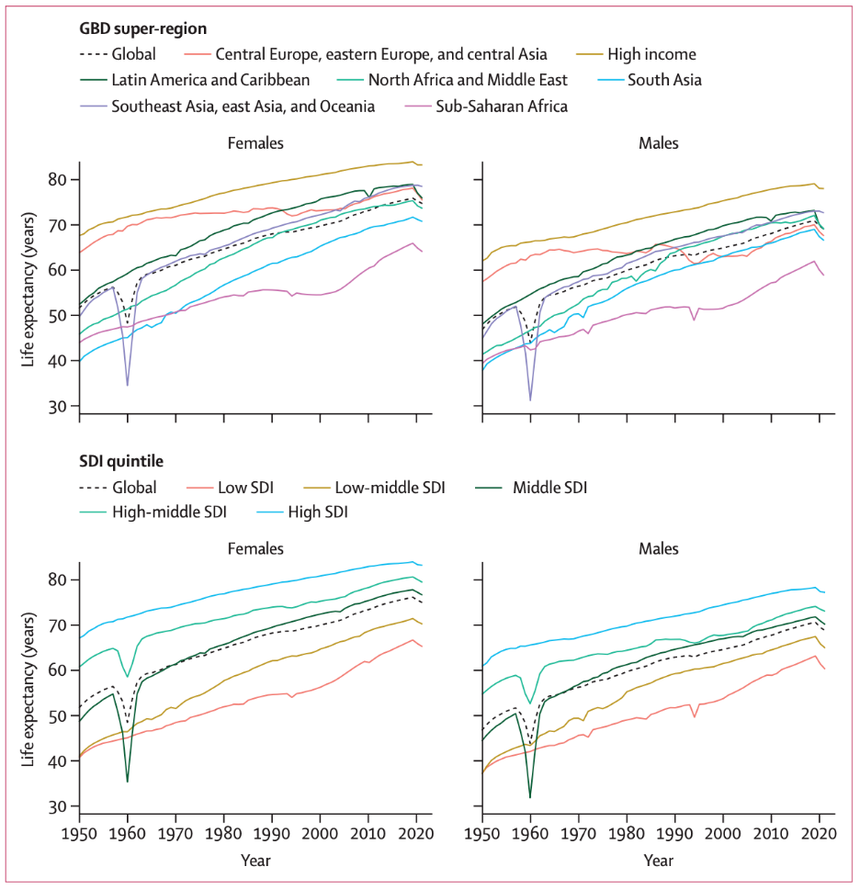Please click the button below to go to our email login page
|
Published in Lancet! The real impact of the COVID-19 pandemic---16 million deaths and global life expectancy decreased by 1.6 yearsIn March 11, 2024, the international top-level medical journal Lancet has published a research paper entitled “Global age-sex-specific mortality, life expectancy, and population estimates in 204 countries and territories and 811 subnational locations, 1950–2021, and the impact of the COVID-19 pandemic: a comprehensive demographic analysis for the Global Burden of Disease Study 2021”.
This research reveals that between 2020 and 2021, the COVID-19 pandemic resulted in a decrease of 1.6 years in global average life expectancy, which is a steeper decline than previous expectation, hinting a sharp reversal of decades of increase in global life expectancy.
Global all-cause mortality followed two distinct patterns between 1950 and 2021: age-standardized mortality rates declined by 62.8% between 1950 and 2019, and increased by 5.1% during the COVID-19 pandemic period.
In 2020 to 2021, there were 0.131 billion deaths globally, among which about 15.9 million people succumbed to the COVID-19 pandemic (measured by excess mortality, including deaths directly due to novel coronavirus infection and those indirectly due to other social, economic, or behavioral changes associated with the pandemic). 80 countries and territories had excess mortality rates exceeding 150 deaths/100,000 populations.
From 1950 to 2021, global life expectancy has been increased by 22.7 years, from 49 years to 71.7 years. However, during the COVID-19 pandemic from 2019 to 2021, the life expectancy has been declined by 1.6 years, reversing the historical trend since 1950. Only 32 (15.7%) of the 204 countries and territories displayed an increase in life expectancy.
The global population reached 7.89 billion people in 2021, and 56 countries and territories that had reached the peak presented decline in population. Between 2020 and 2021, the largest proportion of population growth was in sub-Saharan Africa and south Asia. From 2000 to 2021, the ratio of the population aged 65 years and older to the population aged younger than 15 years increased in 188 (92.2%) of the 204 countries and territories.
Austin Schumacher, the leader of this research, pointed out that the COVID-19 pandemic has more far-reaching influence on global adult population than any other events happening in the last half century (including military conflicts and natural disaster). According to the analysis, during 2020 and 2021, decrement in average life span was found in 84% of the 204 countries and territories, revealing the potential destructive effect of this novel virus.
Besides, this research found that in the first two year of the pandemic, the mortality rate increased by 22% for male aged 15 years and older and 17% for female in the same age group. The decrease in life expectancy was severest in Mexico City, Peru and Bolivia. However, the good news is that compared to 2019, half a million fewer children under five died in 2021 (decreased from 5.21 million in 2019 to 4.66 million in 2021), extending the long-term downward trend in child mortality. Despite setbacks during the pandemic, people live longer in the current stage than in the past in the long run, and human average life expectancy increased from 49 to 72 years from 1950 to 2021.
This research estimated that there was excess mortality of 15.9 million people (calculated by comparing the total number of deaths to the mortality in the absence of the COVID-19 pandemic) during the COVID-19 pandemic between 2020 and 2021, including deaths due directly to COVID-19 infection and indirect deaths due to the pandemic-related damage. This number was one million higher than previous estimates by the World Health Organization.
This research also confirmed that the excess mortality rate during the COVID-19 pandemic was the lowest in Barbados, New Zealand, Antigua, Barbuda and other island countries, reflecting that isolated islands often can escape from the effects of COVID-19. In addition, the population reduced in many aging and high-income countries, while increasing in low-income countries (such as most African countries). |


